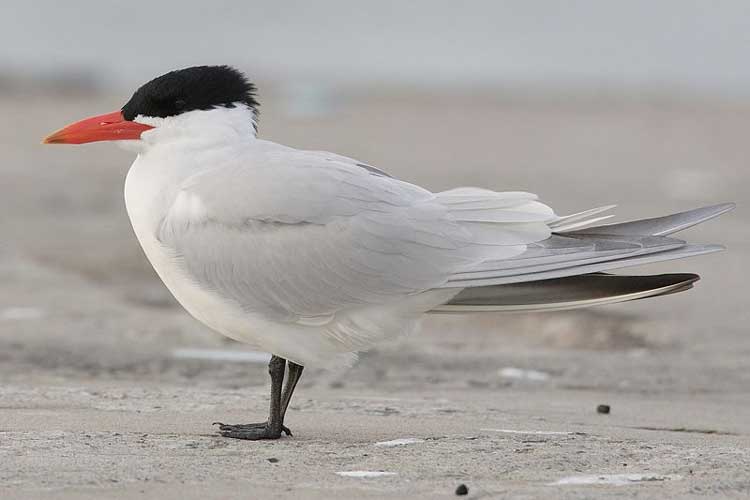
Hydroprogne caspia (*)
Superregnum: Eukaryota
Cladus: Unikonta
Cladus: Opisthokonta
Cladus: Holozoa
Regnum: Animalia
Subregnum: Eumetazoa
Cladus: Bilateria
Cladus: Nephrozoa
Superphylum: Deuterostomia
Phylum: Chordata
Subphylum: Vertebrata
Infraphylum: Gnathostomata
Megaclassis: Osteichthyes
Cladus: Sarcopterygii
Cladus: Rhipidistia
Cladus: Tetrapodomorpha
Cladus: Eotetrapodiformes
Cladus: Elpistostegalia
Superclassis: Tetrapoda
Cladus: Reptiliomorpha
Cladus: Amniota
Classis: Reptilia
Cladus: Eureptilia
Cladus: Romeriida
Subclassis: Diapsida
Cladus: Sauria
Infraclassis: Archosauromorpha
Cladus: Crurotarsi
Divisio: Archosauria
Cladus: Avemetatarsalia
Cladus: Ornithodira
Subtaxon: Dinosauromorpha
Cladus: Dinosauriformes
Cladus: Dracohors
Cladus: Dinosauria
Ordo: Saurischia
Cladus: Eusaurischia
Subordo: Theropoda
Cladus: Neotheropoda
Cladus: Averostra
Cladus: Tetanurae
Cladus: Avetheropoda
Cladus: Coelurosauria
Cladus: Tyrannoraptora
Cladus: Maniraptoromorpha
Cladus: Maniraptoriformes
Cladus: Maniraptora
Cladus: Pennaraptora
Cladus: Paraves
Cladus: Eumaniraptora
Cladus: Avialae
Infraclassis: Aves
Cladus: Euavialae
Cladus: Avebrevicauda
Cladus: Pygostylia
Cladus: Ornithothoraces
Cladus: Ornithuromorpha
Cladus: Carinatae
Parvclassis: Neornithes
Cohors: Neognathae
Cladus: Neoaves
Ordo: Charadriiformes
Subordo: Lari
Familia: Laridae
Subfamilia: Sterninae
Genus: Hydroprogne
Species: Hydroprogne caspia
Name
Hydroprogne caspia (Pallas, 1770)
Synonyms
Sterna caspia Pallas, 1770 (protonym)
Sterna tschegrava Lepechin, 1770 (suppressed)
Hydroprogne tschegrava (Lepechin, 1770) (suppressed)
References
Novi Commen. Acad. Sci. Imp. Petrop. 14 (1): 582, pl.22, fig.2
ICZN (1970). Opinion 904 (tschegrava suppressed)
Vernacular names
Afrikaans: Reusesterretjie
azərbaycanca: Xəzər susüpürəni
български: Каспийска рибарка
brezhoneg: Skrav-Kaspia
čeština: Rybák velkozobý
dansk: Rovterne
Deutsch: Raubseeschwalbe
ދިވެހިބަސް: މިޔަރެމު ދޫނި
Ελληνικά: Καρατζάς
English: Caspian Tern
Esperanto: Kaspia ŝterno
español: Pagaza Piquirroja
suomi: Räyskä
Nordfriisk: Hääfbaker
français: Sterne Caspienne
magyar: Lócsér
հայերեն: Ծովածիծառ կասպիական
íslenska: Ránþerna
italiano: Sterna maggiore
日本語: オニアジサシ
lietuvių: Plėšrioji žuvėdra
Māori: Taranui
Bahasa Melayu: Burung Camar Kaspian
Nederlands: Reuzenstern
norsk: Rovterne
polski: Rybitwa wielkodzioba
português: Gaivina-de-bico-vermelho
русский: Чеграва
slovenčina: Rybár veľkozobý
svenska: Skräntärna
Türkçe: Hazar sumrusu
中文(繁體): 裡海燕鷗
中文: 红嘴巨鸥
The Caspian tern (Hydroprogne caspia)[2] is a species of tern, with a subcosmopolitan but scattered distribution. Despite its extensive range, it is monotypic of its genus, and has no accepted subspecies.[3] The genus name is from Ancient Greek hudros, "water", and Latin progne, "swallow". The specific caspia is from Latin and, like the English name, refers to the Caspian Sea.[4]
Description
It is the world's largest tern with a length of 48–60 cm (19–24 in), a wingspan of 127–145 cm (50–57 in) and a weight of 530–782 g (18.7–27.6 oz).[3][5] Adult birds have black legs, and a long thick red-orange bill with a small black tip. They have a white head with a black cap and white neck, belly, and tail. The upper wings and back are pale grey; the underwings are pale with dark primary feathers. In-flight, the tail is less forked than other terns, and wingtips are black on the underside.[3] In winter, the black cap is still present (unlike many other terns), but with some white streaking on the forehead. The call is a loud heron-like croak.[6]
Distribution and habitat
Their breeding habitat is large lakes and ocean coasts in North America (including the Great Lakes), and locally in Europe (mainly around the Baltic Sea and Black Sea), Asia, Africa, and Australasia (Australia and New Zealand). North American birds migrate to southern coasts, the West Indies and northernmost South America. European and Asian birds spend the non-breeding season in the Old World tropics. African and Australasian birds are resident or disperse over short distances.[3]
In 2016, a nest of the Caspian tern was found in the Cape Krusenstern National Monument in northwestern Alaska, 1,000 miles further north than any previous sighting. This development was part of a general trend in Alaska of species moving to the north, a tendency ascribed to global warming.[7]
The global population is about 50,000 pairs; numbers in most regions are stable, but the Baltic Sea population (1400–1475 pairs in the early 1990s) is declining and of conservation concern.[3][8]
The Caspian tern is one of the species to which the Agreement on the Conservation of African-Eurasian Migratory Waterbirds (AEWA) applies.
Behaviour
Feeding
They feed mainly on fish, which they dive for, hovering high over the water and then plunging. They also occasionally eat large insects, the young and eggs of other birds and rodents. They may fly up to 60 km (37 mi) from the breeding colony to catch fish; they often fish on freshwater lakes as well as at sea.[3][6]
Breeding
Egg, Collection Museum Wiesbaden
Breeding is in spring and summer, with one to three pale blue-green eggs, with heavy brown spotting, being laid. They nest either together in colonies, or singly in mixed colonies of other tern and gull species. The nest is on the ground among gravel and sand, or sometimes on vegetation; incubation lasts for 26–28 days. The chicks are variable in plumage pattern, from pale creamy to darker grey-brown; this variation assists adults in recognizing their own chicks when returning to the colony from feeding trips. Fledging occurs after 35–45 days.[3]
References
BirdLife International (2015). "Hydroprogne caspia". IUCN Red List of Threatened Species. 2015: e.T22694524A84639220. doi:10.2305/IUCN.UK.2015.RLTS.T22694524A84639220.en.
Bridge, E.S.; Jones, A.W.; Baker, A.J. (2005). "A phylogenetic framework for the terns (Sternini) inferred from mtDNA sequences: implications for taxonomy and plumage evolution". Molecular Phylogenetics and Evolution. 35 (2): 459–469. doi:10.1016/j.ympev.2004.12.010. PMID 15804415.
del Hoyo, J.; Elliot, A.; Sargatal, J., eds. (1996). Handbook of the Birds of the World. Vol. 3. Barcelona: Lynx Edicions. p. 645. ISBN 978-84-87334-20-7.
Jobling, James A (2010). The Helm Dictionary of Scientific Bird Names. London: Christopher Helm. pp. 93, 197. ISBN 978-1-4081-2501-4.
"Wild About Terns: Looking After Our Shorebirds" (PDF). Department of the Environment and Climate Change NSW.
Mullarney, K.; Svensson, L.; Zetterström, D.; Grant, P.J. (1999). Collins Bird Guide. Collins. ISBN 978-0-00-219728-1.
Milman, Oliver (23 September 2016). "Terns follow record warm temperatures in 'shock' migration to north of Alaska". The Guardian. Retrieved 2016-09-27.
Snow, D.W.; Perrins, C.M. (1998). The Birds of the Western Palearctic (Concise ed.). Oxford University Press. ISBN 978-0-19-854099-1.
Retrieved from "http://en.wikipedia.org/"
All text is available under the terms of the GNU Free Documentation License

